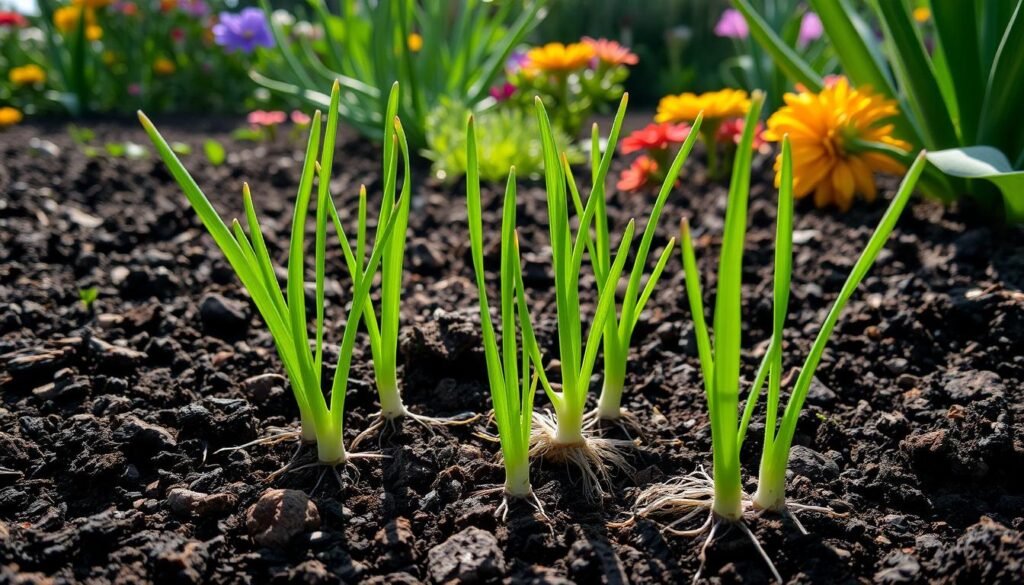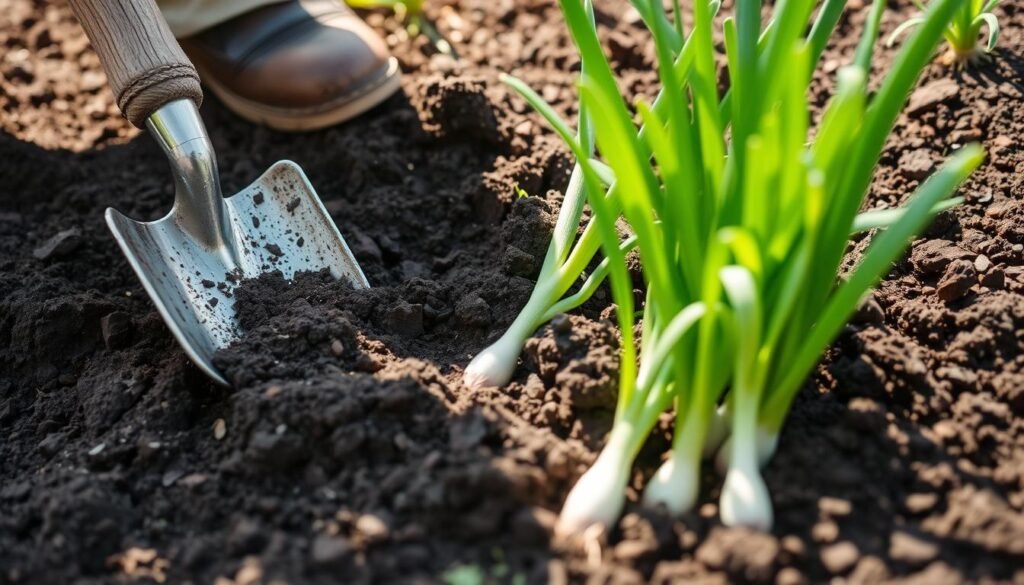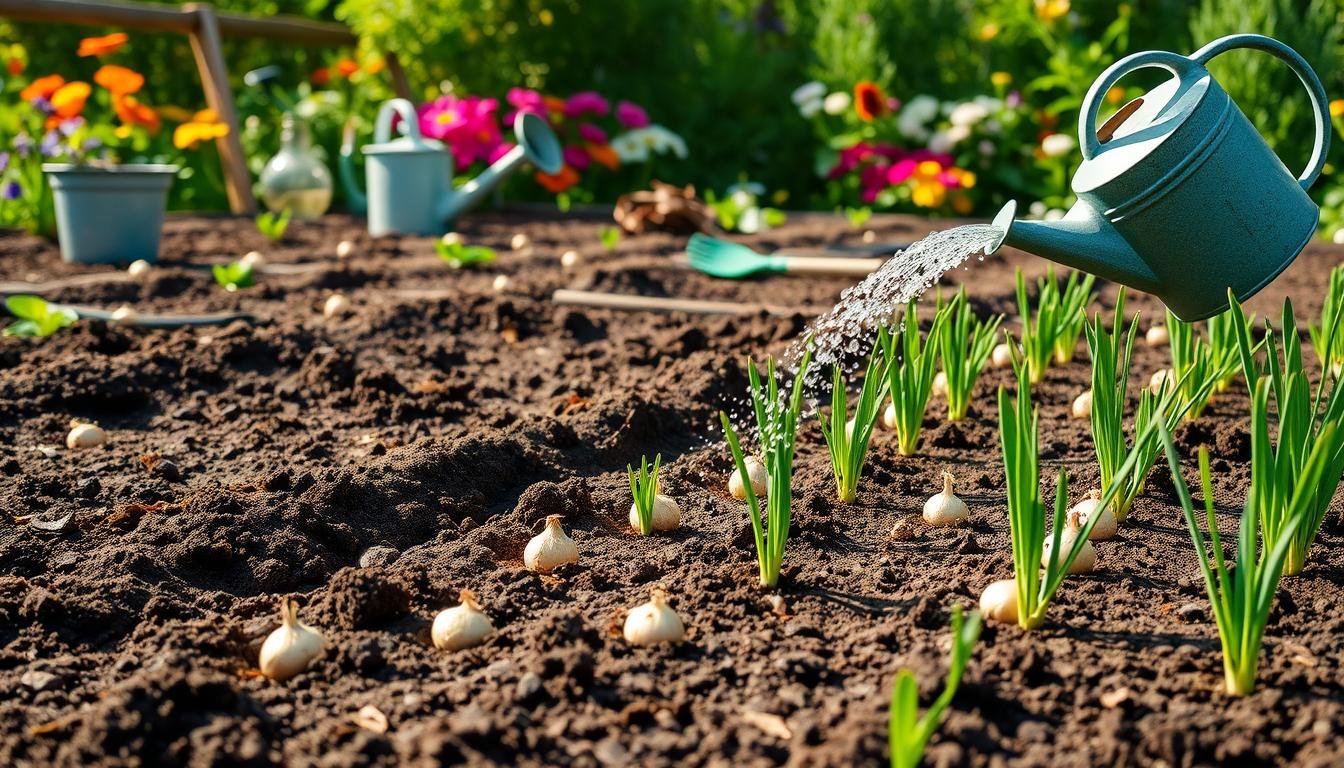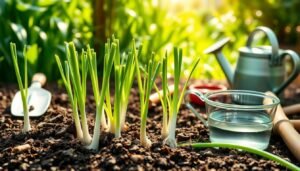Did you know the average American eats about 20 pounds of onions each year? This shows how much people love onions. Growing your own onions can give you the freshest taste and health benefits.
Onions are a top choice for home gardens. They make food taste better and are easy to grow. This guide will teach you how to grow onions well. You’ll learn about their growth, harvesting, and storage. Start your journey into growing onions today!
Table of Contents
Understanding Onions and Their Growth Cycle
Starting to grow onions means knowing their life cycle and which varieties fit your climate. Onions have different stages of growth. Knowing these can help you grow onions better.
The Life Cycle of Onion Plants
Onion plants have three main stages: vegetative, bulbing, and flowering. In the vegetative phase, they grow 8-12 leaves. This depends on the soil and weather.
When onions mature, they enter the bulbing phase. This is when they grow big and noticeable. If the weather is right, they might flower in the second year, for biennial varieties.
Onion Varieties and Their Characteristics
Picking the right onion variety for your climate is key. Onions are grouped by how they react to daylight. This affects their growth and yield.
- Short-day onion varieties: These start bulbing with 10-12 hours of sunlight. They do well in southern states. Vidalia, Yellow Granex, Texas Sweet, and Red Creole are popular.
- Intermediate-day onion varieties: They start bulbing with 12-14 hours of sunlight. They’re good for the central United States. Yellow Candy and Super Star are notable.
- Long-day onion varieties: These start bulbing with 14-16 hours of sunlight. They’re best for northern regions. Walla Walla, Red River, and Highlander are examples.
Choosing the right variety for your climate can lead to bigger, healthier bulbs. This means a more successful onion harvest.
How to Grow Onion: Seeds or Sets?
Deciding between growing onions from seed or using onion sets changes your gardening experience. Each method affects growth rate, bulb size, and weather resilience. Knowing the benefits of onion sets helps choose the best option for your garden.
Advantages of Using Onion Sets
Onion sets have many benefits for gardeners:
- Faster establishment: They start growing faster because they are already partially grown.
- Resilience to cold: Sets can handle light freezes, letting you plant earlier in spring.
- Fewer choices in varieties: While there are fewer sets, this makes choosing easier for gardeners.
Starting Onions from Seeds: A Step-by-Step Guide
Growing onions from seed is rewarding but needs planning. Follow these steps for success:
- Timing: Start seeds 10-12 weeks before the last frost, or up to 16 weeks for similar bulb sizes as sets.
- Indoor sowing: Plant seeds in a well-drained container with quality soil and drainage holes for healthy germination.
- Temperature and light: Keep them warm and provide enough light to prevent seedlings from becoming leggy.
- Transplanting: Harden off seedlings before moving them outside in early spring for larger bulbs.
Knowing the average days to maturity for onion varieties helps plan planting:
| Onion Variety | Days to Maturity | Light Requirements |
|---|---|---|
| Long-Day | 90-110 days | 14+ hours |
| Short-Day | 110 days (warm zones), 75 days (cold zones) | 10-12 hours |
| Day-Neutral | 110 days | 12-14 hours |

Choosing onion varieties that fit your local climate is key for growth. Onions grown from seeds don’t bloom in the first year, allowing for bigger bulbs. Growing onions from seed can be rewarding for your cooking and self-sufficiency goals.
Choosing the Right Location for Planting Onions
Choosing the right spot for onions in your garden is key for a good harvest. Onions need full sun to grow well. Pick a place that gets at least six hours of direct sunlight a day.
Sunlight Requirements for Onions
Onions love bright sunlight for growth. Not enough sun can make plants weak and bulbs small. Keep these tips in mind when picking a spot:
- Find a sunny spot for good light.
- Stay away from shaded areas under trees or buildings.
- Watch how light changes in your garden at different times.
Soil Preparation for Optimal Growth
Soil quality is very important for onion plants. To prepare the soil well, follow these steps:
- Make sure the soil drains well and is rich in nutrients.
- Keep the pH level between 6.0 and 6.8 for onions.
- Add compost to the soil to improve its structure and nutrients.
Before planting, enrich the soil with compost in the fall. This makes the soil better over time. Plant onions 3-5 inches apart in rows 12 inches apart. This spacing helps avoid overcrowding, which can reduce yields by up to 40%.

By preparing the soil and choosing a sunny spot, you’re setting up your onions for success. Follow these steps to make sure your onions grow well.
Best Practices for Growing Onions
To get a great onion harvest, knowing the best growing practices is key. Focus on watering, fertilizing, and managing weeds and pests. These steps help onions grow strong and healthy.
Watering Needs and Techniques
Onions need steady moisture. They require about one inch of water each week, more in dry weather. Here’s how to keep them hydrated:
- Water deeply but not too often to help roots grow strong.
- Don’t overwater, as it can cause rot. Look out for yellow leaves and soft bulbs.
- Try drip irrigation to water the roots directly.
Fertilizing Onions for Bigger Bulbs
Right fertilization is key for big onion bulbs. Start with organic fertilizer rich in phosphorus after planting. Then, switch to high nitrogen fertilizer three weeks later for better growth. Remember these tips:
- Test your soil to see if it has the right nutrients.
- Use urea (45-0-0) side dressings at 0.25 to 0.5 pounds per 25 feet of row.
- Don’t over-fertilize, as it can make too much foliage and small bulbs.
Managing Weeds and Pests Effectively
Controlling weeds and pests is vital for a healthy onion crop. Here’s how to do it:
- Use mulch without herbicides to keep weeds down and hold moisture.
- Check often for pests like onion flies and thrips. Use insecticidal soap or neem oil if you find them.
- Pick disease-resistant onion varieties to avoid problems like Fusarium basal rot and Botrytis neck rot.
Planting Onions in Your Garden
Knowing when to plant onions is key for a good harvest. The right time depends on your area’s climate. We’ll look at the best ways to plant onions, including the best times and methods.
When to Plant Onions Based on Your Climate
The best time to plant onions varies by location. In the north, start onion seeds in spring for a late summer or fall crop. In the south, plant seeds in fall or late winter for an early summer crop. Plant onion sets outside in late March or April when soil is at least 50°F.
Make sure not to plant when it’s colder than 28°F (-2°C). This helps onions grow well.
Techniques for Planting Onion Sets and Seeds
For onion sets, pick bulbs about 3/4 inch in diameter for better success. Plant them 10-15 cm apart in rows, with 30 cm between rows. Plant them 1 to 1½ inches deep.
If growing from seeds, onions take 90-100 days to mature. Add one inch of compost to each row to improve the soil.
Keep onions 2 to 6 inches apart to give them room to grow. Use a balanced nitrogen fertilizer at planting for healthy growth.
| Planting Method | Planting Depth | Spacing | Days to Maturity |
|---|---|---|---|
| Onion Sets | 1 to 1½ inches | 10-15 cm apart | About 80 days |
| Onion Seeds | 0.5 to 1 inch | 4 inches apart | 90-100 days |
By following these planting techniques, you can get a great onion harvest.

Onion Care Guide: Ensuring Healthy Growth
To grow strong onions, you need to care for them all the way. Watch for signs of stress in onion plants and use mulch to help them grow well.
Monitoring Growth Stages and Signs of Stress
Keep an eye on your onions as they grow. They take about 90 to 100 days to get ready. Look out for signs of stress in onion plants like wilting or yellow leaves.
Seedlings need about an inch of water a week. Grown onions need the same. Too much water can cause root rot.
- Watch for wilting or discoloration.
- Check for any unusual growth patterns.
- Ensure proper watering and drainage.
Implementing Mulching Techniques
Mulching helps onions by keeping moisture in and weeds out. Use grass clippings or straw to mulch. It keeps the soil moist and helps onions grow big.
Here’s how to mulch:
- Put mulch two to three inches thick around onions.
- Replace mulch as it breaks down.
- Don’t cover the onion necks to avoid rot.

By watching your onions and using mulch, you can help them grow well. This onion care guide helps you grow healthy onions in your garden.
| Mulching Material | Benefits |
|---|---|
| Grass Clippings | Retains moisture, suppresses weeds |
| Straw | Improves soil quality, regulates temperature |
| Wood Chips | Long-lasting, enhances organic matter |
Harvesting Onions at Home
Starting to harvest onions at home requires knowing the right time and method. It’s key to harvest when onions are at their best. Look for when half of the green tops have fallen over and the outer skins are dry and papery. This means the bulbs are ready.
Determining the Right Time to Harvest
Watch for these signs to know when to harvest:
- The tops of the onions beginning to fall over.
- The outer skin feeling dry and papery.
- Colors changing to a dull hue, indicating maturity.
When you see these signs, it’s time to start harvesting.
Techniques for Harvesting Without Damage
Using the right methods to harvest onions is important. It helps keep the bulbs from getting damaged. Here’s how to do it:
- Start by loosening the soil around the bulbs with a garden fork or hand trowel.
- Gently lift the onions from the soil, making sure not to bruise them.
- After lifting, place them on the ground in a shaded area to prevent sun exposure, which can lead to spoilage.
By following these techniques, you can ensure your onions are of high quality. This is important for the curing process. It helps keep your onions fresh for months.
Storing Your Onions for Longevity
After you harvest your onions, it’s key to store them right. This keeps them fresh and good to use for a long time. Using the right methods for curing onions and storing them well can make them last longer and stay better quality.
Best Practices for Curing Onions
Curing onions is a must to get them ready for long storage. Here’s how to do it right:
- Put the onions in a warm, airy spot, but not in direct sunlight. This helps them dry well.
- Let them cure for two to three weeks, depending on how humid it is.
- Make sure the roots and outer skins are dry before storing. Moisture can cause them to spoil.
Ideal Storage Conditions to Prevent Spoilage
Storing onions properly is key to keeping them fresh for a long time. Here are some tips:
- Keep whole, raw onions in a cool, dry place, like between 30°F and 50°F. They can last up to a year under these conditions.
- Don’t store onions near potatoes, as it can make them spoil faster.
- For cut onions, use a tight container in the fridge. They’ll stay fresh for about a week. But, finely chopped onions might only last a day or two.
- If you need to store them longer, freezing is a good option. Raw onions can be frozen for up to eight months. Cooked onions can last about twelve months when frozen right.
Following these steps for curing onions and storing them well can make them last longer. This way, you can keep your onions fresh and tasty for later use.
Conclusion
Learning to grow onions in your garden is a mix of choosing the right varieties, using good planting methods, and knowing how to care for them after harvest. The Vidalia onion industry shows how onion farming can grow when done right. With the right planning and care, you can have a big harvest of these tasty bulbs.
It’s important to use the right soil mix, including nitrogen and sulfur, and keep the soil’s pH just right. Following tips for growing onions, like spacing them correctly and picking them at the right time, will help them grow strong. These steps will help you get the most from your garden and enjoy your hard work.
Onions are key in cooking and for health, so growing them at home makes your diet better and boosts your gardening skills. Now that you know how, you’re ready to start growing onions. You’ll enjoy every part of the journey, from planting to harvesting and more.



